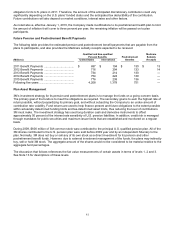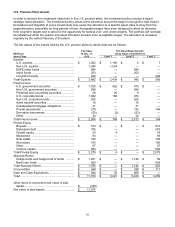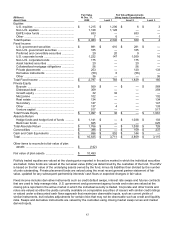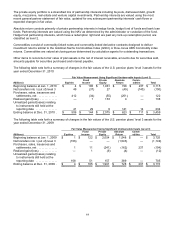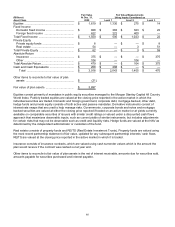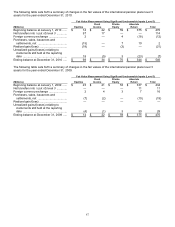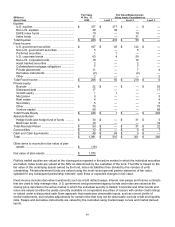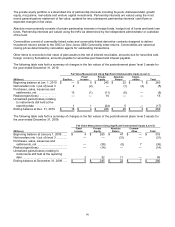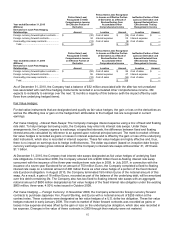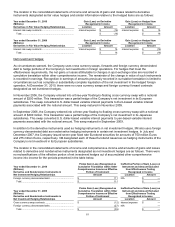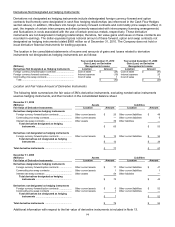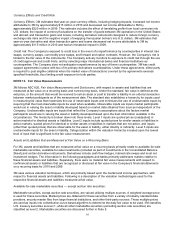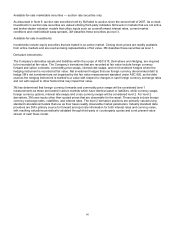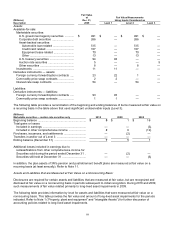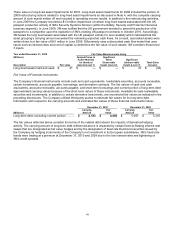3M 2010 Annual Report Download - page 97
Download and view the complete annual report
Please find page 97 of the 2010 3M annual report below. You can navigate through the pages in the report by either clicking on the pages listed below, or by using the keyword search tool below to find specific information within the annual report.
91
NOTE 12. Derivatives
The Company uses interest rate swaps, currency swaps, commodity price swaps, and forward and option contracts
to manage risks generally associated with foreign exchange rate, interest rate and commodity price fluctuations. The
information that follows explains the various types of derivatives and financial instruments used by 3M, how and why
3M uses such instruments, how such instruments are accounted for, and how such instruments impact 3M’s financial
position and performance.
Additional information with respect to the impacts on other comprehensive income of nonderivative hedging and
derivative instruments is included in Note 6. Additional information with respect to the fair value of derivative
instruments is included in Note 13. References to information regarding derivatives and/or hedging instruments
associated with the Company’s long-term debt are also made in Note 10.
Types of Derivatives/Hedging Instruments and Inclusion in Income/Other Comprehensive Income
Cash Flow Hedges:
For derivative instruments that are designated and qualify as cash flow hedges, the effective portion of the gain or
loss on the derivative is reported as a component of other comprehensive income and reclassified into earnings in
the same period during which the hedged transaction affects earnings. Gains and losses on the derivative
representing either hedge ineffectiveness or hedge components excluded from the assessment of effectiveness are
recognized in current earnings.
Cash Flow Hedging - Foreign Currency Forward and Option Contracts: The Company enters into foreign exchange
forward and option contracts to hedge against the effect of exchange rate fluctuations on cash flows denominated in
foreign currencies and certain intercompany financing transactions. These transactions are designated as cash flow
hedges. The settlement or extension of these derivatives will result in reclassifications (from accumulated other
comprehensive income) to earnings in the period during which the hedged transactions affect earnings. Generally,
3M dedesignates these cash flow hedge relationships in advance of the occurrence of the forecasted transaction.
The portion of gains or losses on the derivative instrument previously accumulated in other comprehensive income
for dedesignated hedges remains in accumulated other comprehensive income until the forecasted transaction
occurs. Changes in the value of derivative instruments after dedesignation are recorded in earnings and are included
in the Derivatives Not Designated as Hedging Instruments section below. Hedge ineffectiveness and the amount
excluded from effectiveness testing recognized in income on cash flow hedges were not material for 2010, 2009 and
2008. The maximum length of time over which 3M hedges its exposure to the variability in future cash flows for a
majority of the forecasted transactions is 12 months and, accordingly, at December 31, 2010, the majority of the
Company’s open foreign exchange forward and option contracts had maturities of one year or less. The dollar
equivalent gross notional amount of the Company’s foreign exchange forward and option contracts designated as
cash flow hedges at December 31, 2010 was approximately $3.4 billion.
Cash Flow Hedging - Commodity Price Management: The Company manages commodity price risks through
negotiated supply contracts, price protection agreements and forward physical contracts. The Company uses
commodity price swaps relative to natural gas as cash flow hedges of forecasted transactions to manage price
volatility. The related mark-to-market gain or loss on qualifying hedges is included in other comprehensive income to
the extent effective, and reclassified into cost of sales in the period during which the hedged transaction affects
earnings. Generally, the length of time over which 3M hedges its exposure to the variability in future cash flows for its
forecasted natural gas transactions is 12 months. No significant commodity cash flow hedges were discontinued and
hedge ineffectiveness was not material for 2010, 2009 and 2008. The dollar equivalent gross notional amount of the
Company’s natural gas commodity price swaps designated as cash flow hedges at December 31, 2010 was $31
million.
The location in the consolidated statements of income and comprehensive income and amounts of gains and losses
related to derivative instruments designated as cash flow hedges are provided in the following table.
Reclassifications of amounts from accumulated other comprehensive income into income include accumulated gains
(losses) on dedesignated hedges at the time earnings are impacted by the forecasted transaction.


